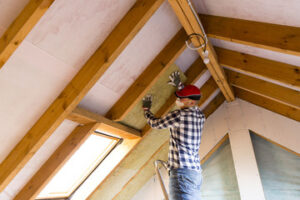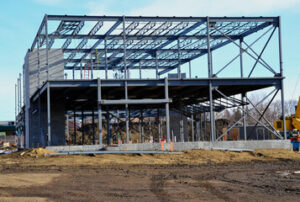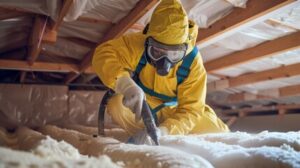Gas leaks can be dangerous, replacing oxygen in the body and causing asphyxiation. They can also cause fires.

Detecting a gas leak early can help prevent these dangers. A professional can use their expertise to safely repair a gas line.
After identifying the location of the gas leak, they must isolate it. This can involve shutting off the gas and/or disconnecting appliances.
Many homes use natural gas to heat their water heaters and power home appliances, such as stoves and clothes dryers. Over time, the seals that connect these piping systems can wear out, or corrode. This is a major safety hazard, and it can lead to a gas leak that needs immediate attention. The first thing to do is recognize the signs of a leak. This includes the smell of rotten eggs, an additive that the gas company uses to alert people of possible leaks.
The next step is to call an emergency plumber that specializes in gas line repairs. These experts will follow a structured and thorough repair process to ensure that the problem is resolved safely and quickly. They will begin by pressurizing the lines with air, soaping down all exposed fittings, isolating the line, and digging up any lines that are underground. Once they have located the leak, they will be able to give you a price for the repair and set up a timeline.
During the repair, it is important to make sure that the area around the pipes is not occupied by anyone else. This is because a sudden ignition of the gas could cause an explosion that will endanger everyone in the area. After the plumber has finished repairing the gas line, they will test it to ensure that there are no more leaks. They will also reinstall the covers and put everything back in place.
It is a good idea to have these professionals inspect your gas lines regularly, especially if you live in an area that has a lot of natural gas production. This is a great way to detect problems before they become dangerous and costly, and it can save you money in the long run. In addition, regular inspections can prevent gas leaks from happening in the first place. This is why it’s always a good idea to call in the experts when you suspect a leak. They can provide you with a cost-effective repair service that will restore the integrity of your home’s gas lines.
Isolating the Area
Gas leaks are serious issues that can threaten the safety of a building’s residents, causing fire outbreaks and health problems. They also wreak havoc on the environment, as methane, which makes up much of natural gas, is a potent greenhouse gas. In order to mitigate these risks, it’s essential that homeowners are able to recognize the signs of a leak and respond quickly with the help of professional commercial plumbers who have experience handling such incidents with technical precision.
The first thing to do when you suspect a leak is evacuate the area and warn anyone else in the vicinity to do the same. You should leave all electronic devices turned off as well, including light switches and phones, as even a tiny spark could ignite the leaking gas. If it’s safe to do so, open windows and doors as you exit to allow accumulated gas to disperse.
You should also turn off the gas supply at the main valve, which is usually located near the meter. This is a crucial step to take, as it’ll prevent the gas from entering your home and prevent any future leaks. It’s also worth noting that you should never tamper with a gas line, regardless of whether it appears to be damaged or leaking. The lines are often pressurized, and a simple mistake can cause an explosion or fire.
Once you’ve safely evacuated the area, you can start preparing for the arrival of a professional plumber. This includes ensuring that you have the contact details of a reliable plumbing company and that they’re licensed to perform such services. It’s also a good idea to look for reviews and recommendations online or ask friends and family for referrals.
As the technician begins working, it’s important to keep them away from any exposed electrical wires or appliances, as these can become a source of ignition. They may also need to use air pressure on gas lines, access the pipes within walls, or excavate the ground to locate and repair a leak. In any case, you should not re-enter the premises until the professional has declared it safe.
Testing the Pipes
A leaking gas line can be a health and safety risk to everyone in your home. It may start as a minor problem but can grow quickly into something much larger if it’s not addressed promptly. Fortunately, professional technicians have the equipment and knowledge to handle a gas leak repair safely.
Leaking pipes are common with both LP (propane) and natural gas lines. These lines connect appliances to your home’s gas supply, so it’s important that they stay in good condition. Over time, the pipes can wear down due to corrosion or simply from age. In addition, accidents like hitting a gas pipe with a shovel or digging into a gas line can also damage them. A faulty valve or connection is another common cause of leaks.
If you suspect a leak in your home, it’s imperative to shut off all gas appliances and call an emergency service right away. The professionals can use a variety of tests to locate and identify the source of the problem. They’ll start by locating the gas shut-off valve and turning it off to prevent any further flow of gas. They’ll then use an electronic gas sniffer to detect and locate the source of the leak.
Other tests the plumber might perform include a visual test to look for black stains around fittings and connections. This indicates that there has been a chronic leak. In addition, a soap solution test can be used to pinpoint the location of a leak. This involves brushing the soap solution on a suspected area and observing for bubble formation, which indicates that gas is being released there.
A final step is to conduct a pressure test of the gas line. This is done by applying a specific psi and observing for a drop in the gauge, which is a clear indication of a leak. Depending on the results of this test, the plumber can then make the necessary repairs and retest the gas line to ensure that the repair is working properly. It’s always a good idea to have these tests performed regularly. This way, you can catch a leak early and avoid the potential for a major disaster.
Reinstalling the Covers
During the repair process, it is important to follow all safety precautions. This includes turning off the gas line as a precautionary measure. It also involves wearing a mask and gloves to avoid inhaling any natural gas. Finally, it is recommended that you work in a well-ventilated area. Additionally, it is a good idea to have a map of your gas lines so that you can mark where the leak is located.
The first step in gas line repair is to thoroughly inspect and test the system. Expert technicians use state-of-the-art tools to meticulously examine the pipes, searching for any problems. The results of this stage will provide the information needed to determine the best course of action.
After the inspection and testing are complete, it is time to start repairing the gas lines. A common method is to use epoxy, which is applied to the damaged areas of the line. Once the epoxy is cured, it is important to tighten the fittings of the high-pressure gas line. After this, it is important to reinstall the covers that were removed during the initial step of the process.
Gas line repair is a major undertaking, and it is essential to know the signs of a gas leak in order to ensure your home’s safety. There are several warning signs that you should watch out for, including the sound of hissing or whistling near your gas lines and appliances. In addition, if you notice the smell of rotten eggs, this could be a sign that gas is leaking from a pipe in your home. Finally, if you see patches of dead plants near your gas line outdoors, this may be a sign that the gas is restricting oxygen to them and they are dying. If you notice any of these symptoms, it is crucial to evacuate the area immediately and call a professional.








